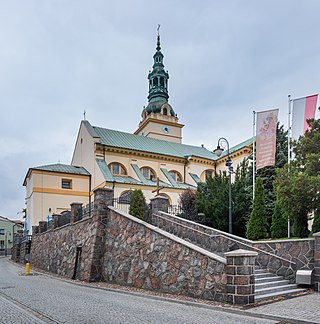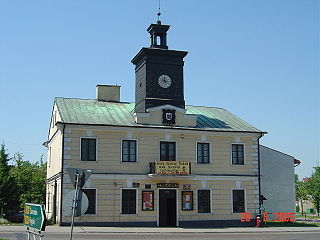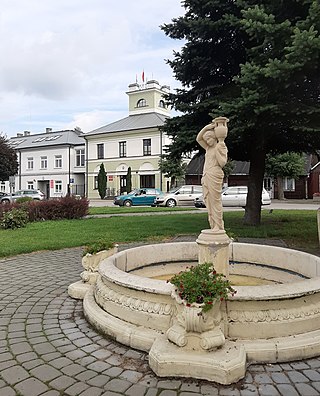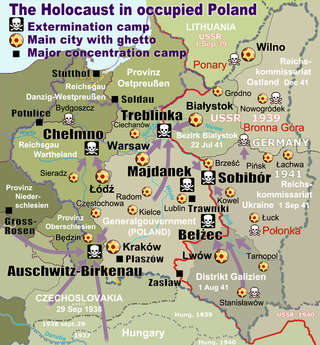Nature
Forest Inspectorate Reserves
There are nine nature reserves in the Grójec Forest Inspectorate, whose total area exceeds 1 thousand hectares.
The following are forest reserves that cover a part of the forested area: Dąbrowa Radziejowska, a 52.50 hectare reserve in a large forest complex in the Radziejowice commune, was created in 1984 to preserve and protect luminous oak wood; Osuchowskie Grądy, a 99,25 hectare reserve was established in 1982 and is at the highest point of the Mazowiecka lowland; Skulski Las, a 311.75 hectare partial forest reserve established in 1984 and includes most of the Skuły Wschód range, situated in the Skuły-Wschód forestry unit; and Skulskie Oaks, a 30,07 hectare partial forest reserve of the area of established in 1996, covering the north-western part of the Skuły-Western range and belonging to the Grójec Forest Inspectorate.
The Łęgacz Nad Jeziorka 37.31 hectare reserve is situated by the Jeziorka River, several hundred meters to the north-west of Głuchów village. The protected area covers a fragment of the river valley and a riparian forest growing on its right bank and marshy bottom of the valley.
The Lakes of Olszyna nature reserve was established by the Ministry of the Environment on 25 January 1995. The forest reserve is in the southern part of the lake district on the Jeziorka River and has a total area is 5.83 hectares, including 4.99 hectares of forest.
The Modrzewina forest reserve was established in 1959 on the grounds of the village of Mała Wieś in the commune of Belsk Duży to protect the northernmost site of Polish larch in the Highland, which grow in this area to a height of 40 meters and up to 120 cm in circumference.
Tomczyce is a landscape reserve of 57.99 hectare, established in 1968, located between the villages of Gostomia and Tomczyce to the east of Nowe Miasto. The reserve protects the steep slope of the Pilica valley, cut by several ravines and overgrown by an old pine-oak forest. The valley slopes from a height of 20 meters to the river, which remains steep due to erosion of the riverbank, running along the foot of the slope and undercutting it periodically.
The Sokół forest reserve was established in 1995 in the commune of Wyśmierzyce to protect the area of forests, meadows and marshes and preserve the plant complexes with the dominant mountain ash for scientific and educational purposes.
Within the territorial range of Grójec Forest Inspectorate there are four Landscape Protection Areas along the picturesque and ecologically important river valleys, namely, the Jeziorka River Valley, Pilica and Drzewiczka River Valley; Bolimowsko Radziejowicki with the Central Rawka River Valley and the Chojnatka River Valley.

Otwock is a city in the Masovian Voivodship in east-central Poland, some 23 kilometres (14 mi) southeast of Warsaw, with 44,635 inhabitants (2019). Otwock is a part of the Warsaw metropolitan area. It is situated on the right bank of Vistula River below the mouth of Świder River. Otwock is home to a unique architectural style called Świdermajer.

Pruszków is a city in east-central Poland, capital of Pruszków County in the Masovian Voivodeship. Pruszków is located along the western edge of the Warsaw metropolitan area.

Suchowola is a town in north-eastern Poland in Sokółka County in the Podlaskie Voivodeship, located on both banks of the Olszanka River. Its population is 2,196 (2017).

Góra Kalwaria is a town on the Vistula River in the Masovian Voivodeship, in east-central Poland. It is situated approximately 35 kilometres southeast of Warsaw and has a population of around 12,109. The town has strong religious significance for both Catholic Christians and Hasidic Jews of the Ger dynasty.

Węgrów is a town in eastern Poland with 12,796 inhabitants (2013), capital of Węgrów County in the Masovian Voivodeship.

Kłobuck is a town in southern Poland, with 12,934 inhabitants (2019). Located in the Silesian Voivodeship, about 15 km northwest of Częstochowa, it is the capital of Kłobuck County. Historically, Kłobuck belongs to Lesser Poland, and is located in its extreme northwestern corner, near the border with two other Polish historical provinces – Greater Poland, and Silesia. The town lies among the hills of Lesser Poland Upland. Most of Kłobuck lies 240 to 260 metres above sea level, and the highest point within town's limits is Dębowa Góra. Kłobuck has the area of 47 km2, with forests taking up 20%.

Marki is a town in central Poland, in the Warsaw metropolitan area in the Masovian Voivodeship, just to the north-east of the Polish capital Warsaw.

Sierpc is a town in north-central Poland, in the north-west part of the Masovian Voivodeship, about 125 km northwest of Warsaw. It is the capital of Sierpc County. Its population is 18,368 (2010).

Sniatyn is a city located in Kolomyia Raion of Ivano-Frankivsk Oblast, in western Ukraine along the Prut river, in the historic region of Pokutia. Sniatyn hosts the administration of Sniatyn urban hromada, one of the hromadas of Ukraine. Population: 9,718. In 2001, population was around 10,500.

Radziejów is a town in Poland, in Kuyavian-Pomeranian Voivodeship, about 45 km south of Toruń. It is the capital of Radziejów County. Its population is 5,696 (2010).

Głowno is a town and community in Poland, in Łódź Voivodeship, in Zgierz County, about 25 km northeast of Łódź. The town administratively belonged to the Łódź Voivodeship from 1975 to 1998. According to data from 2020, the city had 13,961 inhabitants.

Żychlin is a town in Kutno County, Łódź Voivodeship, Poland, about 50 north of Łódź and 90 kilometres west of Warsaw. It has 7,964 inhabitants (2020).

Tarczyn is a town in central Poland, seat of Gmina Tarczyn, in the Piaseczno County, in Masovian Voivodeship, about 30 kilometres south of Warsaw. There were 3,919 inhabitants living there in 2010. This town became famous for the eponymous juices that were made there.

Mogielnica is a town in Grójec County in Masovian Voivodeship, Poland, with 2,475 inhabitants (2004) and an area of 141.56 square kilometres. It is the seat of Gmina Mogielnica.

Przedbórz is a town in Radomsko County, Łódź Voivodeship, Poland, with 3,458 inhabitants (2020). Przedbórz is situated on the Pilica River in the northwestern corner of the historic province of Lesser Poland. From its foundation until the Partitions of Poland, it belonged to Lesser Poland’s Sandomierz Voivodeship.

Skidzyelʹ or Skidel is a town in Grodno District, Grodno Region, Belarus. It is located 31 kilometres (19 mi) east from Grodno. As of 2024, it has a population of 9,707.

Protected areas of Poland include the following categories, as defined by the Act on Protection of Nature of 16 April 2004, by the Polish Parliament:

Nature reserves in Poland cover a total area of 1,644,634 hectares, representing 0.53% of the territory of Poland. As of 2011, Poland has 1469 nature reserves.

The Słonim Ghetto was a Nazi ghetto established in 1941 by the SS in Slonim, Western Belarus during World War II. Prior to 1939, the town (Słonim) was part of the Second Polish Republic. The town was captured in late June 1941 by the Wehrmacht in the early stages of Operation Barbarossa. Anti-Jewish measures were promptly put into place, and a barb-wire surrounded ghetto had been created by 12 July. The killings of Jews by mobile extermination squads began almost immediately. Mass killings took place in July and November. The survivors were used as slave labor. After each killing, significant looting by the Nazis occurred. A Judenrat was established to pay a large ransom; after paying out 2 million roubles of gold, its members were then executed. In March 1942, ghettos in the surrounding areas were merged into the Słonim ghetto.























